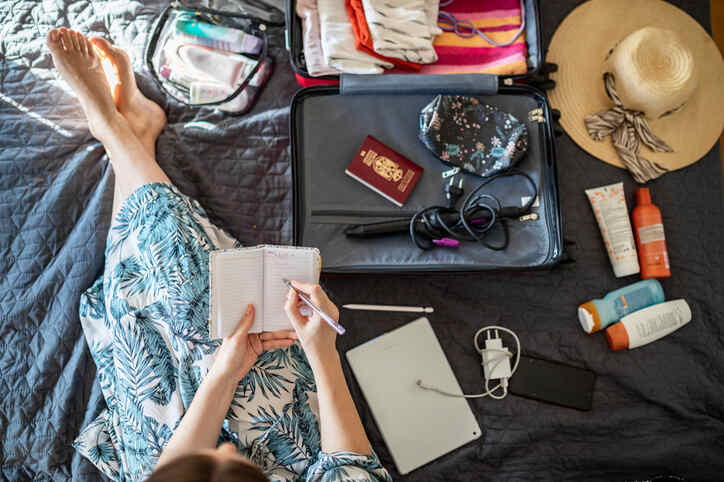Essential Tips on How to Pack a Backpack for Any Adventure
Learn how to pack a backpack efficiently with our guide. Discover tips on gear selection, organization, weight distribution, and protecting your gear.
Correct Way to Pack a Backpack for Adventure
-
Choose the right size backpack for your trip, ensuring it fits comfortably and has essential features like padding, ventilation, and multiple compartments.
-
Pack necessary clothing, food, and must-haves like a sleeping bag, sleeping pad, and lightweight tent. Use a layered clothing system and compression techniques to save space.
-
Test your packed backpack at home, tighten straps, and do a shakedown hike to ensure comfort and functionality. Make necessary adjustments before heading out.
Picking a destination for your backpacking trip can be tricky, but packing a backpack can be trickier. It’s because what you pack and how you pack are equally important. If you’re traveling with just a backpack (which we recommend), you’ll want to pack efficiently so that you’re using your limited space well, everything is organized and your bag is comfortable to carry.
You can do these three with a bit of planning. If you need help to simplify this cumbersome process then we can help shed some crucial light.
Backpack Selection and Preparation
Before you get to what to pack and how to fit it all in, what you pack into has to be your first step. There are many factors to consider when choosing a backpack; the main ones are fit, comfort and purpose.
Choose the Right Size Backpack for Your Trip
Choosing the right backpack is key to a successful trip. The size of your backpack should match the length of your trip and the amount of gear you need to carry. For a short weekend trip, a 30-50 liter backpack might be enough. For longer trips, consider a 50-70 liter pack.
You will also need to consider the length of your trip, estimate how many days you’ll be out and then assess your food and clothing needs based on the trip length and conditions. Weather conditions play a big part; cold weather trips will require more gear, bulkier clothing and a warmer sleeping bag. Of course, factor in your fitness level and endurance and choose a pack you can carry for extended periods.
You also need to look for:
- Separate Compartments and Pockets for help with organization and making it easier to get to your gear.
- Hip Belt Pockets for snacks, sunscreen and other small items you need to get to quickly.
- Water Bottle Pockets for water bottles and other frequently used items.
- Front Pocket for items you may need on the go, like a map, compass or rain jacket.
Consider Comfort and Safety Features
Carrying heavy weights along the hairpin bend of a steep hill is a challenge in itself. You don't need to further this challenge by adding discomfort from the weights. Therefore, when choosing a backpack, look for features that enhance comfort and functionality. For example:
Backpack Padding: Quality padding on the shoulder straps, hip belt, and back panel is essential. This padding helps distribute the weight evenly, reducing strain on your shoulders and hips. Look for backpacks with adjustable and contoured padding that conform to your body shape for maximum comfort.
Backpack Insulation: Insulated backpacks can keep your water and food supplies at the desired temperature. This is particularly useful in extreme weather conditions, ensuring that your provisions remain safe and consumable.
Ventilation Systems: A good ventilation system can prevent your back from becoming excessively sweaty, which can lead to discomfort and chafing. Look for backpacks with mesh back panels and ventilation channels that promote airflow.
Adjustable Suspension System: An adjustable suspension system allows you to customize the fit of your backpack, ensuring that it sits comfortably on your hips and shoulders. This system can help distribute the weight more evenly and reduce fatigue.
Load Lifters and Sternum Straps: Load lifter straps help pull the weight of the backpack closer to your body, improving balance and stability. A sternum strap helps keep the shoulder straps in place and prevents them from slipping off your shoulders.
Packing Essentials
Next, assemble the necessary gear for your trip. Begin by determining the gear list based on the season and location of your trip.
Clothing
Generally, for a backpacking trip, you must keep at least 5 changes of underwear, socks, t-shirts, and tracksuit bottoms no matter the duration of your trip. Consider packing light weight clothing like swimsuits, microfiber towel, umbrella, raincoat, thermal jackets, gloves, dresses, and jumpsuits based on the weather and terrain of your destination.
Food and nutrition
For a backpacking trip, aim to pack 2-2.5 pounds of food per person per day, and choose calorie-dense options so you have enough energy. Pack lightweight, high-calorie foods that require minimal prep. Think dehydrated meals, trail mix, nuts, energy bars, dried fruits etc.
Must Haves
Must-haves are a sleeping bag, a sleeping pad for comfort and a lightweight tent or hammock with a rainfly. Make sure your sleeping bag is rated for the weather. An inflatable or foam sleeping pad provides insulation from the ground and adds to comfort.
Packing Strategies
Here are some packing strategies once you have your backpack and your list.
Organization and Weight Distribution
Packing is not just about getting everything in your backpack; it’s about getting the load to be manageable and balanced. The key here is weight distribution. Place the heaviest items closest to your mid-back, between your shoulder blades.
This helps with stability and reduces back strain. Organize your gear into zones: keep frequently used items like snacks, maps and rain gear in easy-to-reach pockets and less frequently used items deeper in the backpack.
Learn to Choose
One of the hardest parts of packing is deciding what to leave behind. Choosing what to bring is a skill that gets better with experience. Focus on safety and comfort: a first aid kit, enough food, water purification methods, and the right layers of clothing are non negotiable.
Don’t overpack by asking yourself if each item is necessary for your safety and comfort. Remember, a lighter backpack means less fatigue and more of the hiking or travel experience.
Master the Art of Compression
Maximizing space in your backpack is all about compression techniques. Compression sacks are a must for compressing sleeping bags and clothing. They allow you to get your gear into smaller, more manageable sizes.
Use the backpack’s compression straps to secure your load and weight distribution. Packing cubes will help with organization, so you can find what you need without having to unpack the whole bag. These cubes can also be used to separate clean clothes from dirty ones or to keep different types of gear separate.
Packing for Comfort and Convenience
Your backpack should be comfortable and convenient so you can get to your stuff without hassle. It may take some trial and error with compartments and packing calls but it’s worth it. Here are some tips:
Pack Heavy Stuff Close to Your Body
To keep your center of gravity, pack the heaviest items (water, food and cooking gear) close to your back and between your shoulder blades. This will help stabilize your load and reduce strain on your back and shoulders.
Use Separate Compartments
Many backpacks have multiple compartments and pockets. Use them to your advantage. For example, put your sleeping bag in the bottom compartment and your cooking gear in a side pocket.
Layer Your Gear
A layered pack where items are packed in the order you’ll need them is key to efficiency and comfort. Keep frequently used items within reach to save time and energy on the trail.
Balance the Load
Make sure the weight is balanced from side to side. An unbalanced pack can be uncomfortable and affect your balance on the trail.
|
Some extra backpack packing tips |
|
|
Use Dry Bags |
Keep your clothes and sensitive items dry with dry bags. Different colors can help with organization. |
|
Stuff Sacks for Small Items |
Use small stuff sacks for toiletries, cooking gear and electronics. |
|
Top-Loading vs. Front-Loading |
Top-loading for simplicity, front-loading for easy access to gear. |
|
Quick Access Pocket |
Designate a pocket for quick access items like headlamp, snacks and map. |
|
Roll Clothing |
Roll your clothing instead of folding to save space and reduce wrinkles. |
|
Use Carabiners |
Attach lightweight items like a water bottle or sandals to the outside of your pack with carabiners. |
|
Layered Clothing System |
Pack a layered clothing system: base layer, insulating layer, and waterproof layer. |
|
Use the Brain |
Use the top compartment, often called the brain, for items you need quick access to like sunglasses, snacks and camera. |
|
Hydration System |
Consider a hydration bladder with a drinking tube so you can drink water without having to stop and take off your pack. Make sure the tube is easy to reach and doesn’t get tangled with other gear. |
Gear Protection
Here are some tips to keep your gear safe from weather, theft and loss.
How to Rainproof Your Backpack
Rain and moisture can be your gear’s worst enemy. Here’s how to keep everything dry and working throughout your adventure:
Use a Waterproof Pack Liner
A waterproof pack liner, like a heavy-duty trash compactor bag or a purpose-made liner, can be placed inside your backpack to keep your gear dry. This is your first line of defense against rain.
Backpack Cover
A waterproof pack cover is a must-have that fits over your backpack to protect it from rain. Look for one that fits your pack volume and cinches around the back panel to prevent water from getting in.
Dry Bags and Stuff Sacks
Use dry bags and waterproof stuff sacks to organize and protect your gear inside your pack. Different colors can help with organization, so you can find things quickly.
Seam Sealing
Some backpacks have waterproof material but may have seams that aren’t fully sealed. Seam sealing your backpack will give you extra protection against leaks.
Fast Dry Gear
Pack items made of quick dry material; in case some gear gets wet. Synthetic clothing and fast-dry towels are good ones.
Using Trash Bags and Other Waterproofing Methods
In addition to pack covers and liners, other waterproofing methods can ensure your gear stays dry and protected:
-
Trash Compactor Bags: These heavy-duty bags are excellent for lining your backpack or separating wet and dry gear. They are more durable than regular trash bags and can withstand rough use.
-
Ziplock Bags: Use ziplock bags to store smaller items like electronics, maps, and first aid supplies. They provide an additional layer of waterproof protection.
-
Silicone Waterproof Sprays: Apply a silicone waterproof spray to your backpack and gear to enhance their water resistance. Make sure to follow the manufacturer's instructions for the desired results.
Protection from Other Elements
Your gear can be exposed to various other elements during your adventure, and taking steps to protect it from each is essential:
|
Condition |
Protection Tips |
|
Sun Protection |
Use a UV-resistant spray on your backpack and other gear to protect them from sun damage, as prolonged exposure to UV rays can degrade materials over time. |
|
Dust and Sand |
When traveling in dusty or sandy environments, use gear covers and keep items in sealed bags to prevent particles from getting into your equipment. |
|
Cold Weather |
In freezing temperatures, protect sensitive items like electronics and water filters by keeping them close to your body or in insulated pockets. Carry spare batteries. |
|
Insects and Animals |
Store food in bear-proof containers or hang it in a tree to keep it away from animals. Use insect-repellent sprays or treated gear to deter bugs. |
Loss and Theft Protection
Protecting your backpack from loss and theft is just as important as protecting it from the natural elements. Here’s how:
-
Keep Your Pack in Sight: It is better to keep your backpack in sight, especially in public places like airports, bus stations and campgrounds. If you need to put it down, put it between your feet or use it as a pillow.
-
Lock It: Lock your zippers with a small padlock or a combination lock to deter theft. Lock your backpack to a fixed object when you need to leave it unattended.
-
Hide Valuables: Keep valuable items like your wallet, phone and passport in hidden or internal pockets. Don’t draw attention to these items by keeping them out of sight.
-
Travel Insurance: Get travel insurance that includes baggage loss coverage. This type of travel insurance coverage can offer reimbursement for your gear if it gets lost, stolen or damaged during your trip. Keep receipts and take photos of your gear for claims.
-
Mark Your Backpack: Personalize your backpack with unique markings like patches or bright-colored ribbons. This will make it easier to identify and less attractive to thieves.
-
GPS Trackers: Consider using a small GPS tracker in your backpack. These devices will allow you to track your pack if it gets lost or stolen.
Final Check and Refinements
Before you head out, do a final check and make any adjustments. You must:
-
Test Your Pack: Once you’ve packed, test your fully loaded pack at home to make sure it’s comfortable for venturing into the unknown. Adjust straps and weight distribution as needed.
-
Shakedown Hike: Do a shakedown hike to test your gear and make sure everything is working. This is also a chance to find out what you forgot and what you can leave behind.
-
Tighten Straps: Once your pack is loaded, tighten compression straps so the gear doesn’t shift. Secure loose ends so they don’t catch on branches or rocks.
-
Emergency Items: Double-check that emergency items, like your first aid kit, whistle and emergency blanket, are easily accessible.
Now that you are done learning the whats and hows of preparing your backpack for any weather conditions and territories, it is time to pick adventures without any worries.
FAQs
1. How do I lighten my backpack?
To lighten your load, pack only what you need and choose lightweight gear. Use multi-use items to reduce what you have to carry. Choose dehydrated or compact food to save space and weight. Regularly go through each item and remove anything non-essential to keep your load manageable.
2. What are the common packing mistakes and how do I avoid them?
Common mistakes are overpacking, poor weight distribution, and not using space efficiently. Make a detailed packing list to prioritize essentials and avoid non-essentials. Put heavier items near your back and center. Regularly review and adjust your packing to improve balance and comfort.
3. How do I keep my backpack tidy on a long trip?
Use packing cubes or ziplock bags to categorize items, so you can find them easily. Store frequently used items in easy-to-reach pockets and reorganize your gear regularly to stay tidy. A consistent system means you can find what you need without having to unpack everything.
4. Where do you pack the tent gear in your backpack?
Pack the tent gear at the bottom of your backpack and balance it with other items. Put the heavier stuff like poles near your back to keep your center of gravity. If you’re hiking with a group, make sure to spread the load across the group (you can break up the tent into body, fly, and poles so each person can carry one part of the tent).
5. What if your backpack gets damaged on the trip?
If your backpack gets damaged, use duct tape or a repair kit for quick fixes. Assess the damage; if it’s minor, repairs can often get you to the end of the trip. If it’s severe, look for a local repair service or replace the backpack so your gear is safe. If you lose any items due to backpack damage, you can also claim.
6. How to pack a backpack for 3 days?
Pack light layers of clothing, a toiletry bag, compact cooking gear, and a pack cover. Use a pack liner to keep items dry, and place heavier items close to your back for balance. Prioritize essentials and leave non-essentials behind for a manageable load.
Also Read: Backpacking, Backpacking: Spain, Backpacking Europe, Backpacking: food, Backpacking Travel Insurance, TSA Prohibited Items

Get AXA Travel Insurance and travel worry free!
Travel Assistance Wherever, Whenever
Speak with one of our licensed representatives or our 24/7 multilingual insurance advisors to find the coverage you need for your next trip Get an instant quote!




